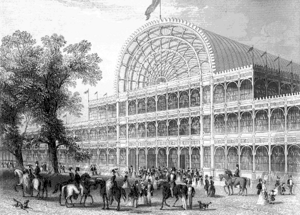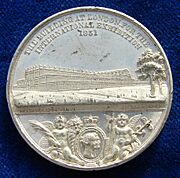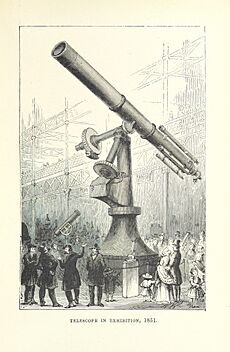Great Exhibition facts for kids
Quick facts for kids Great Exhibition of the Works of Industry of All Nations |
|
|---|---|

The Great Exhibition 1851
|
|
| Overview | |
| BIE-class | Universal exposition |
| Category | Historical Expo |
| Name | Great Exhibition of the Works of Industry of All Nations |
| Building | The Crystal Palace |
| Area | 10.4 ha (26 acres) |
| Invention(s) | Telegraph, vulcanised rubber |
| Visitors | 6,039,722 |
| Location | |
| Country | United Kingdom of Great Britain and Ireland |
| City | London |
| Venue | Hyde Park, London |
| Coordinates | 51°30′11″N 0°10′12″W / 51.50306°N 0.17000°W |
| Timeline | |
| Opening | May 1 – October 15, 1851 (5 months and 2 weeks) |
| Closure | 15 October 1851 |
| Universal expositions | |
| Next | Exposition Universelle in Paris |
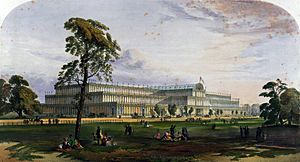
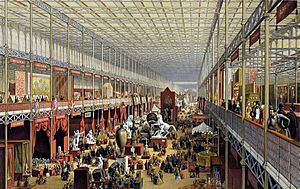
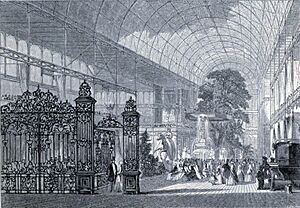
The Great Exhibition of the Works of Industry of All Nations, often called the Great Exhibition, was a huge international event. It took place in Hyde Park, London from May 1 to October 15, 1851. People also called it the Crystal Palace Exhibition because of the amazing glass building where it was held.
This event was the very first of its kind, starting a trend of World's Fairs. These fairs showed off new culture and industry from around the globe. Prince Albert, who was married to Queen Victoria, helped organize it with Henry Cole.
Many famous people visited the Great Exhibition. These included scientists like Charles Darwin and Michael Faraday. Writers such as Charlotte Brontë and Charles Dickens also came. Even the first international chess tournament happened at the exhibition. The world's first soft drink, Schweppes, was an official sponsor.
Contents
Why the Great Exhibition Happened
The Great Exhibition was a big celebration of new industrial technology and design. Prince Albert and others from the Royal Society of Arts helped plan it. A main goal was to show the world that Britain was a leader in industry.
Britain wanted to prove its skills in many areas. British exhibits were top-notch in things like iron, steel, machinery, and textiles. The exhibition also aimed to give people hope for a better future. Europe had faced tough times, and Britain wanted to show that technology could lead to progress.
The displays were carefully arranged. Large "trophy" exhibits of art and raw materials were placed in important spots. Technology and working machines were very popular. Visitors could even watch cotton being made from start to finish. Scientific tools like electric telegraphs and microscopes were also on display.
The Amazing Crystal Palace
A special building was created just for the exhibition. It was called The Crystal Palace. Joseph Paxton designed this incredible structure. It was built with help from structural engineer Charles Fox. The whole building went from idea to grand opening in just nine months!
The Crystal Palace was a huge glass house. It was about 563 meters (1,848 feet) long and 138 meters (454 feet) wide. It was made mostly from cast iron and glass. These materials came from cities like Birmingham and Smethwick. Inside, the building was so big that it even enclosed full-grown trees. This showed how humans could control nature.
The Crystal Palace was a massive success. It was seen as an amazing piece of architecture and engineering. It showed how important the exhibition itself was. Later, the building was moved and rebuilt in Sydenham Hill in south London. Sadly, it was destroyed by fire in 1936.
Visitors and What Happened Next
About six million people visited the Great Exhibition. This was about a third of Britain's entire population at the time! On one busy day, over 109,000 people attended. Thomas Cook helped 150,000 people travel to the event, which helped his travel company grow.
The exhibition made a profit of about £186,000. This money was used to create famous museums in London. These include the Victoria and Albert Museum, the Science Museum, and the Natural History Museum. These museums are in an area nicknamed Albertopolis. The remaining money helped set up an educational trust. This trust still gives grants for industrial research today.
Some people worried about the exhibition before it opened. They feared that so many visitors might cause trouble. However, the event went smoothly and was a huge success. Today, the Great Exhibition is a symbol of the Victorian Age. A memorial with a statue of Prince Albert stands behind the Royal Albert Hall. It lists facts about the exhibition, like how many people visited.
A variety of medals were given out to those who showed their work, judged, or helped with the exhibition.
-
1851 medal The Crystal Palace in London by Allen & Moore, front side
-
1851 medal The Crystal Palace in London by Allen & Moore, back side
Cool Things on Display
The official guide to the event listed 13,000 exhibitors. They came from all over Britain, its colonies, and 44 other countries. The exhibits included many new inventions and interesting items.
- The Mintons company showed off their beautiful ceramics, including majolica. These became very popular worldwide.
- The Koh-i-Noor diamond, known as the "Mountain of Light," was a major attraction. It was the largest known diamond at the time.
- The Daria-i-Noor, a rare pale pink diamond, was also on display.
- The ancient Tara Brooch from Ireland was shown. It was found just a year before the exhibition.
- Alfred Charles Hobbs showed how easy it was to pick some respected door locks.
- Frederick Bakewell demonstrated an early version of a fax machine.
- Mathew Brady won a medal for his amazing daguerreotype photographs.
- William Chamberlin, Jr. showed what might have been the world's first voting machine. It counted votes automatically.
- The first modern pay toilets were installed. Over 800,000 visitors paid a penny to use them. This is where the phrase "spending a penny" comes from!
- Firearms maker Samuel Colt showed his new revolver designs.
- The Tempest prognosticator, a barometer that used leeches to predict storms, was demonstrated.
- The America's Cup yacht race began with a race held during the Great Exhibition.
- Beautiful gold and silver crafts from the Sunar caste in Sind, British India were displayed.
- C.C. Hornung from Denmark showed Europe's first piano with a single-cast iron frame.
- The "Trophy Telescope" was considered the best telescope at the exhibition. It had a large lens and was made in London and Ipswich.
- The instrument maker J. S. Marratt showed a five-foot telescope and a transit theodolite. This tool is used for surveying and astronomy.
- Asprey displayed a fancy lady's dressing case made of kingwood and gold.
- The New Zealand exhibit featured natural resources. It also showed items made by Māori, like flax baskets and carved wooden objects.
How Much it Cost to Visit
The price to enter the Crystal Palace changed over time. It was more expensive at the beginning and became cheaper later. This was to encourage more people to visit.
- A season ticket cost two guineas (a guinea was about £1.05).
- For the first two days, a daily ticket was £1.
- Then, the price dropped to five shillings per day.
- Later, it was reduced even more to just one shilling per day.
- Fridays cost two shillings and six pence, and Saturdays stayed at five shillings.
The one-shilling ticket was very popular with working-class people. About four and a half million shillings were collected this way. To help people travel, the new railways offered cheap tickets from far away places. Special rates were given to groups, often led by local church leaders. People who couldn't afford to travel would line up by the railway tracks to watch the trains go by.
Souvenirs and 3D Views
The Great Exhibition led to many souvenirs being made. One popular type was stereoscope cards. These cards gave a three-dimensional view of the exhibition. They were paper cards, often hand-colored, and folded to create a 3D effect. Visitors could look through small holes to see a miniature Crystal Palace. People bought these souvenirs to remember their visit.
See also
 In Spanish: Gran Exposición para niños
In Spanish: Gran Exposición para niños
- List of world's fairs
- 1862 International Exhibition, held in London.
- Festival of Britain
- Great Exhibition Bay
- Prince Albert's Model Cottage




